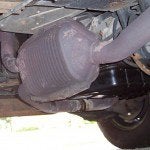
Every car comes standard with a catalytic converter so that the amount of pollution generated by driving cars is reduced. In fact, federal, state and local governments have passed statutes and ordinances that require you to have your vehicle inspected on an annual basis to ensure that its catalytic converter is functioning proplery and preventing pollution.
This brief guide to catalytic converters can help you better understand your catalytic converter and know when it may need to be serviced. Remember, the key to ensuring that your vehicle stays road ready for years to come is to take care of it by undergoing routine maintenance procedures.
What is A Catalytic Converter?
Catalytic converters are small metal boxes found on the underside of your car, truck or SUV. Two pipes are connected to catalytic converters. The first pipe runs from the engine to the converter and transports polutants so that they can be converted into exhuast by the converter. The second pipe runs fromt the catalytic converter to the exhuast and forces the converted byproducts out through your vehicle’s tail pipe.
How Does It Work?
When the poillutants reach the catalytic converter, chemical catalysts are added to aid in converting the pollutnats into acceptable exhuast. There are two primary processes by which converstaion occurs.
- Reduction: reduction is the process of removing oxygen from nitorgen oxide (a harmful pollutant). Removing oxygen from nitrous oxygen breaks the compound into sinlge molocules of oxygn and nirtogen (neither of which are harfmul).
- Oxidation: oxidation is the process of adding oxygen to carbon monoxide (a toxin) to convert it into carbon dioxide (which is less toxic).
